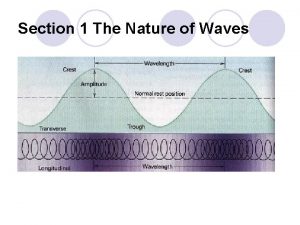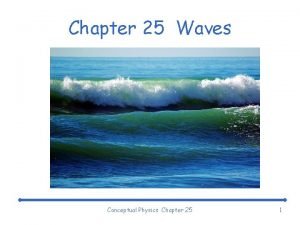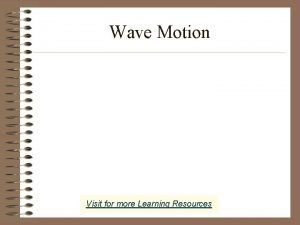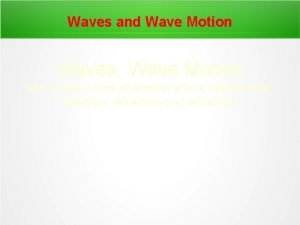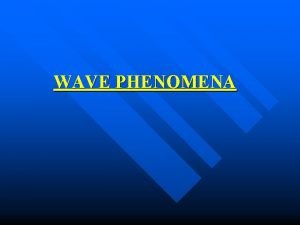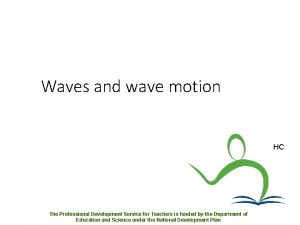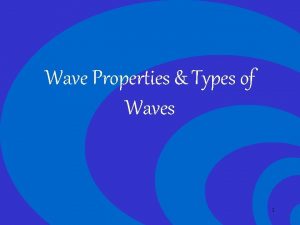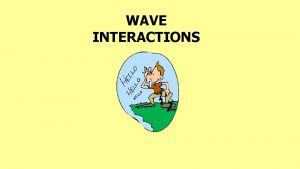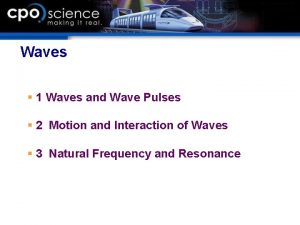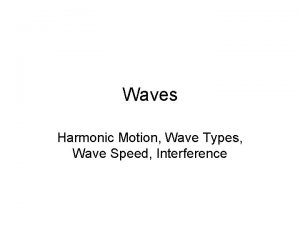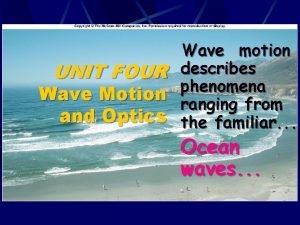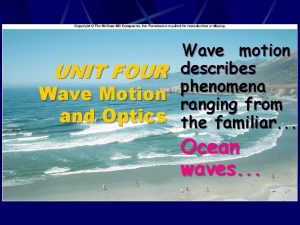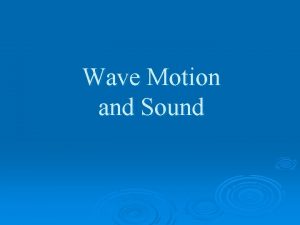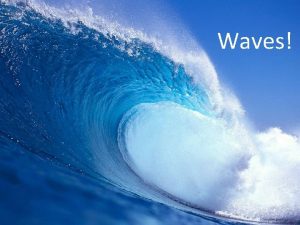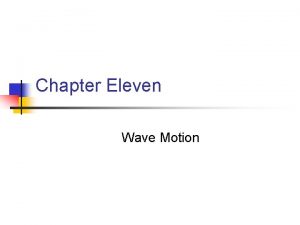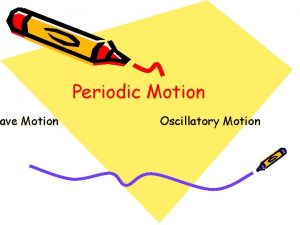Waves and wave motion HC The Professional Development









































- Slides: 41

Waves and wave motion HC The Professional Development Service for Teachers is funded by the Department of Education and Science under the National Development Plan

Can you think of some examples of waves?

Waves • Sound • Light • Water • Radio • Seismic.

What is the function of a wave? § A wave is a means of transferring energy from one place to another

TYPES OF WAVES § Waves are classified into different types according to their natures :

Wave Types Mechanical Electromagnetic e. g. Water waves, waves on a e. g. Radio, X-Rays, Light rope, sound Must have a substance to travel through Does not need a substance to travel through but can travel through various substances Cannot travel in a vacuum Can travel in a vacuum Vibrations passed on from molecule to molecule Travel at very fast speed in a vacuum: 3 × 108 m/s

Travelling Waves § Waves that travel from one place to another § e. g. Waves on rope § e. g Waves on water § e. g. compression waves on spring

Compression and Rarefraction


Longitudinal wave

Types Of Waves

TRANSVERSE A wave where the direction of the vibration is perpendicular to the direction in which the wave travels LONGITUDINAL A wave where the direction of the vibration is parallel to the Direction in which the wave travels.

Transverse Waves Transverse waves § A transverse wave is a one in which the direction of vibration is perpendicular to the direction of propagation. Examples § Light waves. § Radio waves. § Waves on a rope. § Water waves

Longitudinal Waves § A longitudinal wave is one in which the direction of vibration is parallel to the direction of propagation. Examples § Sound waves in a solid, liquid or gas. § Compression waves on a spring. § Seismic waves.

Wave. . § The wavelength of a wave is the distance from one point on the wave to the corresponding point on the next cycle. §

§ The frequency of a wave is a measure of the number of oscillations (vibrations) of the wave per second. § The periodic time of a wave (T) is the time taken for one complete cycle.

Symbols and units Variable Symbol Unit Symbol for Unit Frequency f Hertz Hz Wavelength metre m v (or c for light) metre/second m/s T second s (“lamda”) Velocity Time

The relationship between frequency, velocity and wavelength c =f or v =f


Properties of waves § 1. Reflection: Reflection is the bouncing of a wave off an object.

Properties of waves § 2 Refraction is the bending of a wave as it travels from one medium to another. Note that when a wave travels from one medium to another its frequency does not change.

Properties of waves § 3. Diffraction is the spreading of waves around a slit or an obstacle. § This effect is only significantly noticeable if the slit width is approximately the same size as the wavelength of the waves.

Properties of waves § 4 Interference occurs when waves from two sources meet to produce a wave of different amplitude.

Interference of Waves When two or more waves propagating in the same medium meet at the same point, interference is said to occur. A stable interference pattern can be observed when two water waves of same frequency meet one another in a ripple tank. = +

Two types of interference Constructive Interference Destructive Interference

Constructive Interference § Constructive Interference occurs when waves from two coherent sources meet to produce a wave of greater amplitude. § (Constructive interference occurs when the crests of one wave are over the crests of another wave).

Destructive Interference § Destructive Interference occurs when waves from two coherent sources meet to produce a wave of lower amplitude. § (Destructive interference occurs when the crests of one wave are over the troughs of the second wave. This will happen if one wave is half a wavelength out of phase with respect to the other).

5. Polarisation Only TRANSVERSE waves can be polarised. To polarise a wave means to make it vibrate in one plane only –horizontally plane polarised or –vertically plane polarised


Polarised sunglasses

The frequency of a wave is a measure of the number of oscillations (vibrations) of the wave per second. Another way of defining frequency of a wave is to say it is the number of waves that pass a fixed point per second. T = 1/f

The relationship between periodic time and frequency T = 1/f or f = 1/T

Standing waves A standing wave/stationary wave is the result of two waves of the same wavelength, frequency, and amplitude travelling in opposite directions through the same medium.

From the diagram we can see that: 1. The distance between two consecutives nodes is /2 2. The distance between two consecutive antinodes is /2 3. The distance between an antinode and the next node is /4

The Doppler Effect • The Doppler effect is the apparent change in frequency of a wave due to the motion of the source or the observer. • The observed frequency is higher when the source and observer are getting closer. • The observed frequency is lower when the source and observer are getting farther away.

Consider a source S emitting a wave with crests 1, 2, 3 as shown. • The distance between successive crests is the constant and so the number of crests passing a point in one second is the frequency of the wave. • These waves will pass an observer in equal intervals of time. • This means that the wavelength, and the frequency, will be constant.

In this case the source is moving to the right while emitting the waves. The result is that: • Ahead of the moving source the crests are closer together than crests from the stationary source would be. This means that the wavelength is smaller and the frequency is greater. • Behind the moving source, the crests are further apart than crests from the stationery source would be. This means the wavelength is greater and so the frequency is less.

Formula: f’ = apparent frequency f = actual frequency c = speed of the wave u = speed of the moving source

Example of the Doppler Effect The noise from a racing car as it approaches and then moves away from an observer is an example of the Doppler effect. This is NOT an APPLICATION of the Doppler effect.

Applications of the Doppler Effect • Police speed traps • Measuring the red shift of galaxies in astronomy

Doppler shift gives radial velocity True Velocity Radial Velocity Tangential Velocity Radar
 Compare and contrast p waves and s waves using venn diagram
Compare and contrast p waves and s waves using venn diagram Transverse waves move perpendicular
Transverse waves move perpendicular Similarities of mechanical and electromagnetic waves
Similarities of mechanical and electromagnetic waves Transfer of energy when a wave disappears into a surface
Transfer of energy when a wave disappears into a surface Short wave vs long wave radiation
Short wave vs long wave radiation Mechanical waves and electromagnetic waves similarities
Mechanical waves and electromagnetic waves similarities Mechanical waves and electromagnetic waves similarities
Mechanical waves and electromagnetic waves similarities Seismic waves
Seismic waves Mechanical wave and electromagnetic wave
Mechanical wave and electromagnetic wave Constructive
Constructive Ability of two or more waves to combine and form a new wave
Ability of two or more waves to combine and form a new wave Longitudinal wave vs transverse wave
Longitudinal wave vs transverse wave What type of waves are sound waves? *
What type of waves are sound waves? * Is echolocation transverse or longitudinal
Is echolocation transverse or longitudinal Mechanical vs electromagnetic
Mechanical vs electromagnetic Is a seismic wave mechanical or electromagnetic
Is a seismic wave mechanical or electromagnetic Difference between full wave and half wave rectifier
Difference between full wave and half wave rectifier Longitudinal vs transverse waves
Longitudinal vs transverse waves Center tapped transformer vs bridge rectifier
Center tapped transformer vs bridge rectifier P and s wave arrival time chart
P and s wave arrival time chart Transverse wave and longitudinal wave example
Transverse wave and longitudinal wave example Full wave rectifier vs half wave rectifier
Full wave rectifier vs half wave rectifier Rectified sine wave fourier series
Rectified sine wave fourier series What is a repeating disturbance
What is a repeating disturbance The nature of waves chapter 10 section 1
The nature of waves chapter 10 section 1 Half wave odd
Half wave odd Chapter 25 conceptual physics
Chapter 25 conceptual physics Range of motion types
Range of motion types Energy in wave motion
Energy in wave motion Waves 1 physics notes
Waves 1 physics notes What is wave motion
What is wave motion Manage personal and professional development
Manage personal and professional development 7 domains of ppst explanation
7 domains of ppst explanation Community linkages example
Community linkages example Manage personal and professional development
Manage personal and professional development Personal and professional development level 6
Personal and professional development level 6 Shm formula
Shm formula An object in motion stays in motion
An object in motion stays in motion Chapter 2 section 1 describing motion answer key
Chapter 2 section 1 describing motion answer key Describing and measuring motion
Describing and measuring motion Chapter 2 motion section 1 describing motion answer key
Chapter 2 motion section 1 describing motion answer key Describing and measuring motion worksheet answer key
Describing and measuring motion worksheet answer key










